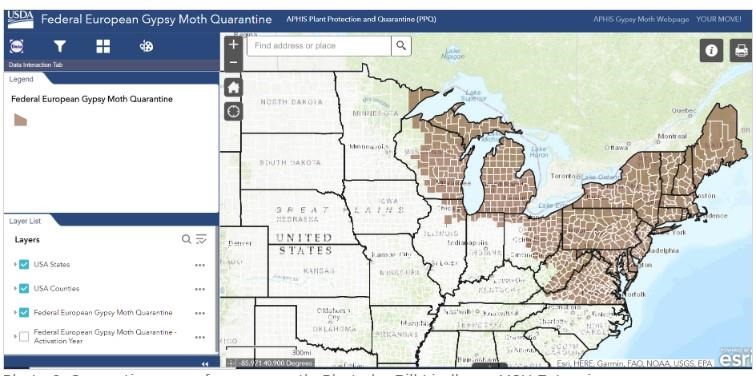By Bill Lindberg and Amber Neils

Photo 1. Spongy moth larva. Photo by Scott Bauer, USDA Agricultural Research Service, Bugwood.org.
Spongy moth (Lymantria dispar) (Photo 1), formerly gypsy moth, is an invasive insect that has become established in Michigan. A detailed description of characteristics and life cycle of spongy moth can be found on Michigan State University’s Spongy Moth website. Although Christmas tree species are generally not the top feeding choice for spongy moth, they will feed on and lay egg masses on any Christmas tree species. Once the Christmas trees are harvested, these egg masses could lead to further distribution of spongy moth if transported into areas not currently infested (i.e., outside of the quarantine area). View the current spongy moth quarantine map. To prevent this scenario, federal spongy moth regulations (Title 7 Code of Federal Regulations 301.45-4) have been put into place by the United States Department of Agriculture (USDA) for which all cut Christmas trees are considered a regulated commodity.
The Michigan Department of Agriculture and Rural Development (MDARD) has an inspection and treatment program to facilitate trade between Michigan and areas outside of the quarantine area. To be eligible for this program, growers must follow certain requirements. Do you need to enroll in MDARD’s inspection program? Michigan State University Extension (MSU Extension) recommends reviewing the scenarios listed below to help determine the answer to that question.
Choose and cut farms: Directly selling trees to customers in Michigan
Since harvested trees are not leaving the state or the affected quarantine area, no further action is required regarding MDARD. You may still want to protect your trees from spongy moth if you are in a heavily infested area or have seen damage. Contact Bill Lindberg, MSU Extension Christmas tree educator, for spray recommendations.
Wholesale farms: Selling trees outside of Michigan
For growers selling harvested trees outside of Michigan, you will need to know ahead of time where your trees are being sold and transported to. If trees are being transported, moved or sold outside of the shaded area (quarantine area) in the map (Photo 2), then you must complete a compliance agreement, apply acceptable preventative insecticide treatments and complete an inspection application to have each field inspected. Forms and information can be found online or requested via phone by calling Amber Neils, MDARD export and compliance specialist at 517-449-0786.
However, if transportation and sales are within the highlighted area (Photo 2), then no further action is required regarding MDARD. You may still want to protect your trees from spongy moth if you are in a heavily infested area or have seen damage to your trees. Contact Bill Lindberg for spray recommendations.
 Photo 2. Quarantine map of spongy moth. Photo by Bill Lindberg, MSU Extension.
Photo 2. Quarantine map of spongy moth. Photo by Bill Lindberg, MSU Extension.Potted or balled and burlapped (B&B) trees
Trees sold as potted trees or as B&B trees are considered nursery stock and must undergo an inspection regardless of their intended destination. See MDARD’s Nursery License Site for additional information on nursery stock.
Wreaths, greenery, production
In some instances, spruce, fir and Douglas-fir branches may harbor spongy moth egg masses. Firms that manufacture products from these branches should discuss the risk of spongy moth spread via their product with MDARD. Training and compliance agreements are offered through MDARD for makers of these products that would help them qualify for certification.
How does the certification process work?
For growers that need to have trees certified by MDARD officials, preventative insecticide treatments are required and must be documented on an inspection application for each field that needs to be certified. At sites where spongy moth is present on the premises and/or in the surrounding area, a USDA-approved regulatory treatment is required. The spray must be applied during the spray window that is most effective for larval control, which varies depending on your location. MSU Enviroweather provides a model to ensure the best timing of these applications based on your local weather station. Sprays applied outside of this spray window will not be accepted by MDARD to meet the quarantine requirements.
The inspection application is due by July 31 and must also include details for the field to be inspected, including a map that allows MDARD inspectors to locate it and clearly understand what is to be inspected. Finally, an MDARD inspector will do a visual inspection of your unharvested field to look for spongy moth egg masses. You can expect the inspection to be completed between the end of August after egglaying is complete and Nov. 15. Timely submission of your inspection application is the best assurance that your field will be inspected in time for harvest. It is a very busy time of year for MDARD inspectors, too.
It is important to note than in addition to the federal spongy moth quarantine, other states may have their own quarantines for other pests that may apply to Christmas trees imported from Michigan, especially for trees going to West Coast states. It never hurts to reach out to MDARD officials and double check quarantine rules.
Source : msu.edu